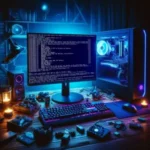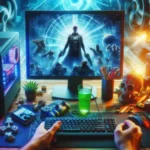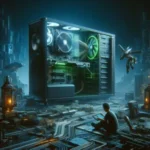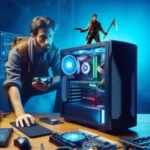In the exhilarating world of PC gaming, few things are more frustrating than encountering technical glitches that disrupt your immersive experience.
Whether you’re battling enemies in a highly competitive online match or exploring vast digital landscapes, unexpected issues can arise at any moment, leaving you feeling defeated before the game even begins. From lag spikes and crashing games to hardware compatibility woes and driver dilemmas, these common pitfalls can sap the joy from even the most anticipated gaming sessions. But fear not! In this comprehensive guide, we’ll delve into the top 10 common PC gaming problems that players often face, offering practical solutions and expert tips to get you back in the game quickly. Say goodbye to the headaches of troubleshooting and hello to uninterrupted gaming bliss as we empower you to tackle these challenges head-on!
1. Introduction to Common PC Gaming Problems

In the dynamic world of PC gaming, players often find themselves caught in a web of technical challenges that can disrupt their immersive experience. Whether you’re a casual gamer or a seasoned pro, encountering issues with your gaming rig can be both frustrating and perplexing. From hardware mishaps to software glitches, these common problems can hinder your gameplay and leave you feeling stuck in a digital quagmire.
As the demand for high-performance gaming continues to grow, so too does the complexity of the technology that supports it. With an ever-evolving landscape of graphics cards, processors, and game titles, it’s no wonder that many gamers face hurdles along the way. Understanding these common issues is the first step toward troubleshooting and ultimately enhancing your gaming experience.
In this blog post, we will explore the top ten common PC gaming problems that players encounter, along with practical solutions to help you get back in the game. Whether it’s dealing with lag, crashes, or compatibility woes, we’ve got you covered with insights and tips to ensure your gaming setup runs smoothly. So gear up as we dive into the world of PC gaming challenges—because every gamer deserves a seamless adventure!
2. Poor Performance: Lag and Frame Rate Issues
When it comes to PC gaming, nothing can be more frustrating than experiencing poor performance characterized by lag and frame rate issues. Imagine finally sitting down to dive into an intense gaming session, only to find your character stuttering across the screen or the action halting just as you’re about to make that crucial move. The smooth flow of gameplay transforms into an unpredictable mess, diminishing the immersive experience that gaming promises.
Lag and frame rate drops can stem from a variety of sources, ranging from hardware limitations to software conflicts. First, ensure your PC meets the game’s minimum system requirements. If your hardware is outdated, it may struggle to keep up with demanding graphics and processing tasks. upgrading components like your graphics card, RAM, and CPU can yield significant improvements in performance.
Another common culprit for performance issues is background applications consuming valuable system resources. Before launching your game, check your task manager and close any unnecessary programs that may be running. This simple step can free up resources and lead to smoother gameplay.
Updating your graphics drivers is another crucial fix. Manufacturers regularly release updates that optimize performance for new games, so make it a habit to check for the latest drivers from your GPU manufacturer’s website. Additionally, adjusting the in-game graphics settings can make a world of difference. Lowering the resolution or turning off resource-hungry features like anti-aliasing and shadows can help stabilize your frame rates without sacrificing too much visual quality.
Lastly, consider checking your internet connection if you’re playing online. Lag can often be attributed to poor connectivity. Using a wired connection instead of Wi-Fi, or upgrading your internet plan, can enhance your gaming experience significantly.
Addressing lag and frame rate issues might require some trial and error, but with a little patience and the right adjustments, you can reclaim the fluidity and excitement that gaming is meant to deliver.
3. Game Crashes and Freezes: Diagnosing the Causes
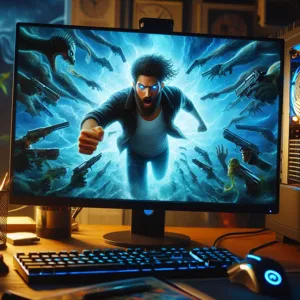
Game crashes and freezes can be a frustrating experience for any PC gamer, often interrupting your epic battles or immersive storylines at the most critical moments. Understanding the root causes of these issues is essential for keeping your gaming experience smooth and enjoyable.
First and foremost, one of the most common culprits is hardware incompatibility or insufficient specifications. If your system doesn’t meet the recommended requirements for a game, you may find yourself facing unexpected crashes. Take a moment to review your PC’s specifications, including the CPU, GPU, and RAM, against the game’s requirements. Upgrading your hardware might be necessary, especially if you’re attempting to run graphically demanding titles.
Another potential cause could be outdated drivers. Graphics drivers are crucial for optimal game performance, and running on outdated versions can lead to instability. Regularly check for updates from your GPU manufacturer—NVIDIA, AMD, or Intel—and ensure you’re using the latest drivers to enhance compatibility and fix bugs.
Additionally, background applications can create conflicts with your games, leading to crashes and freezes. Programs that hog resources or interfere with game processes should be minimized or closed before launching your game. Use Task Manager to identify and terminate unnecessary applications running in the background.
Lastly, corrupted game files can also be a significant factor in game instability. Many gaming platforms, like Steam or Epic Games, offer built-in tools to verify the integrity of game files. Running this verification can help identify and repair any corrupted files, allowing you to dive back into your gaming adventure without further interruptions.
By diagnosing these common issues—hardware inadequacies, outdated drivers, conflicting applications, and corrupted files—you can take proactive steps to ensure a smoother gaming experience and reduce the likelihood of crashes and freezes. After all, the only thing that should freeze is your character during an intense moment of gameplay!
4. Graphics Glitches: Fixing Visual Artifacts
Graphics glitches can be some of the most frustrating issues a PC gamer can encounter. These visual artifacts can manifest in numerous ways, from strange textures and flickering screens to bizarre character models that seem to defy the laws of physics. Such glitches not only disrupt immersion but can also hinder gameplay, making it essential to address them promptly.
To start tackling graphics glitches, first ensure that your graphics drivers are up to date. Outdated drivers can lead to compatibility issues with the latest games, so visit the website of your graphics card manufacturer—whether it’s NVIDIA, AMD, or Intel—and download the latest versions. Many manufacturers also offer software that can automatically detect and install updates for you, saving you time and ensuring your drivers are always current.
Next, check your in-game settings. Sometimes, graphics settings that are too high for your hardware can lead to glitches. Lowering settings like texture quality, shadows, and anti-aliasing can improve stability and eliminate artifacts. Experimenting with these settings can help you find a sweet spot where the visuals remain appealing while performance is optimized.
Another potential cause of graphics glitches is overheating. When your GPU gets too hot, it may struggle to render images correctly. Ensure that your computer is well-ventilated and that fans are functioning properly. Cleaning dust from vents and components can also aid in maintaining optimal temperatures. If overheating continues to be a problem, consider investing in better cooling solutions or even reapplying thermal paste to your GPU.
Lastly, if all else fails, it might be worth verifying the integrity of your game files. Many gaming platforms, such as Steam, have built-in features that allow you to check for corrupted files and automatically repair them. This step can resolve issues that stem from improper installations or updates, providing a straightforward solution to persistent graphics problems.
By following these steps, you can tackle and resolve graphics glitches effectively, ensuring that your gaming experience remains smooth and visually stunning. Don’t let visual artifacts ruin your adventures—take action and get back to enjoying the immersive worlds that PC gaming has to offer!
5. Audio Problems: No Sound or Distorted Audio
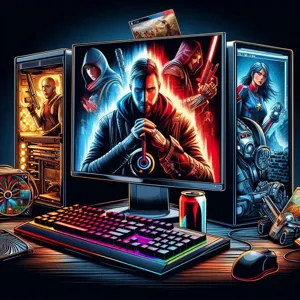
Audio problems can be one of the most frustrating issues PC gamers encounter, often disrupting the immersive experience that gaming provides. Whether it’s complete silence or distorted sound resembling a garbled mess, these audio glitches can turn even the most thrilling gameplay into a frustrating endeavor.
First and foremost, check your physical connections. Ensure that your speakers or headphones are securely plugged into the correct audio jack. Sometimes a loose connection can cause sound to drop out or distort. If you’re using a headset, double-check that the mute button isn’t accidentally engaged.
Next, dive into your computer’s audio settings. Right-click the speaker icon in the system tray and select “Playback devices.” Here, make sure the correct output device is set as default. If you’re using multiple audio devices, such as an HDMI monitor along with standard speakers, your PC might be sending the audio signal to the wrong device.
If you’ve confirmed your connections and settings are correct but still face audio issues, it might be time to update your audio drivers. Outdated or corrupted drivers can lead to a multitude of sound-related problems. Visit the manufacturer’s website for your sound card or use Device Manager to search for updates.
In some cases, it may be a game-specific issue. Check the in-game audio settings to ensure the volume levels are appropriately adjusted and that sound isn’t muted. Additionally, verify that the game files are intact—most platforms, like Steam, offer a function to verify the integrity of game files, which can resolve any corruption that may be causing audio issues.
Lastly, if all else fails, consider checking for system updates or even reinstalling the game as a last resort. Audio problems can be vexing, but with a methodical approach to troubleshooting, you can often resolve these issues and get back to enjoying your gaming experience to the fullest.
6. Connectivity Issues: Troubleshooting Online Play
Connectivity issues can be one of the most frustrating barriers to enjoying your favorite online games. Whether you’re in the heat of battle or trying to complete a challenging quest, lag, disconnections, and other network problems can quickly ruin the experience. Understanding how to troubleshoot these connectivity issues is crucial for every gamer.
Start by checking your internet connection. Ensure that your Wi-Fi signal is strong or, better yet, consider using a wired Ethernet connection for more stability. A weak signal can lead to lag spikes and frequent disconnections, making it almost impossible to enjoy multiplayer games. If you’re using Wi-Fi, try moving closer to the router or eliminating any physical barriers that could interfere with the signal.
Next, restart your modem and router. Sometimes, simply power cycling these devices can resolve underlying issues. Unplug them for about 30 seconds, plug them back in, and wait for the lights to stabilize before testing your connection again.
If you’re still experiencing issues, check for any bandwidth hogs on your network. Streaming services, downloads, or other devices connected to your internet can consume significant bandwidth, leading to slower connectivity for gaming. Pausing or limiting these activities while you play can help improve your gaming experience.
Additionally, consider checking your game’s server status. Sometimes, the issue isn’t on your end at all; the game’s servers might be experiencing outages or maintenance. You can usually find this information on the game’s official website or social media channels.
Lastly, ensure your firewall and antivirus settings aren’t interfering with your gameplay. Sometimes, these security measures can mistakenly block game data. Adding your game to the exceptions list or temporarily disabling them can help identify if they are the cause of your connectivity woes.
By following these troubleshooting steps, you can minimize connectivity issues and focus on what truly matters: enjoying your gaming adventures with friends and fellow players.
7. Compatibility Problems: Running Games on Older Hardware
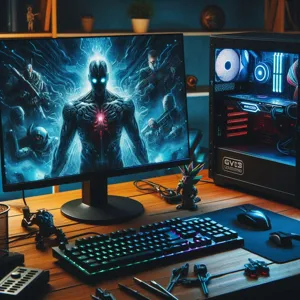
When diving into the world of PC gaming, one of the most frustrating hurdles players encounter is compatibility issues, particularly when trying to run games on older hardware. As game developers push the boundaries of graphics and processing power, the requirements for new titles often leave older systems struggling to keep up. If you’re still gaming on a legacy setup, you may find that your favorite game stutters, crashes, or refuses to launch altogether due to outdated components.
The first step in addressing compatibility problems is to check the minimum system requirements for the game you want to play. These specifications are typically found on the game’s packaging or its digital storefront page. If your hardware falls short, consider upgrading your components where possible. For instance, adding more RAM or upgrading your graphics card can significantly improve performance and compatibility with newer titles.
If upgrading isn’t an option, there are still strategies to enhance your gaming experience. Lowering the graphics settings in the game’s options menu can alleviate some strain on older hardware. Disabling features like shadow effects, anti-aliasing, and reducing the resolution can help boost frame rates and make the game more playable.
Additionally, compatibility mode settings in Windows can also be a lifesaver. By right-clicking on the game executable, navigating to the properties, and selecting the compatibility tab, you can run the game as if it were being played on an older version of Windows. This sometimes resolves issues that arise from newer operating systems not fully supporting older software.
Lastly, consider reaching out to gaming forums or communities. Many seasoned gamers have faced similar compatibility issues and can offer valuable insights or workarounds that may not be immediately obvious. With a little patience and creativity, you can often find a way to keep the gaming experience alive on your older hardware, ensuring that you can continue to enjoy your favorite titles without the headache of constant compatibility problems.
8. Overheating: Managing Your PC’s Temperature
Overheating is a common enemy for PC gamers, often leading to frustrating performance drops, unexpected shutdowns, and even hardware damage. As your gaming rig powers through graphics-intensive titles, the components can generate substantial heat, making it crucial to keep temperatures in check.
To manage your PC’s temperature effectively, start by ensuring that your gaming setup is well-ventilated. place your PC in an open area, away from walls or obstructions that might restrict airflow. Dust buildup can also hinder cooling performance, so make it a habit to clean your PC regularly. Use compressed air to blow out dust from fans, heatsinks, and filter screens, ensuring unobstructed airflow.
Consider upgrading your cooling solution if you find your temperatures still run high. Aftermarket CPU coolers, additional case fans, or even liquid cooling systems can significantly enhance your rig’s cooling efficiency. Ensure that the thermal paste between your CPU and its cooler is properly applied; over time, the thermal paste can dry out and lose its effectiveness.
Monitoring software can be a gamer’s best friend. Tools like MSI Afterburner or HWMonitor can help you keep an eye on your system’s temperatures in real-time. This way, you can take proactive measures before things get too hot to handle. If you notice consistent overheating even after these adjustments, it may be time to evaluate the workload of your components or consider underclocking for a more stable gaming experience.
By addressing overheating issues head-on, you can significantly extend the life of your gaming PC and ensure that your gaming sessions remain smooth and enjoyable. Don’t let overheating be the reason you miss out on epic victories—take control and keep your PC cool!
9. Input Lag: Improving Mouse and Keyboard Response
Input lag can be a gamer’s worst nightmare, transforming smooth gameplay into a frustrating experience filled with missed shots and delayed reactions. This frustrating delay between your commands and your on-screen character’s actions can stem from various factors, but the good news is that there are effective solutions to enhance your mouse and keyboard response.
First and foremost, ensure that your gaming peripherals are of high quality and designed for performance. Invest in a gaming mouse and keyboard that have lower latency and faster polling rates. A polling rate of 1000 Hz is ideal, as it allows your devices to communicate with your PC every millisecond, translating into quicker response times.
Next, consider adjusting your in-game settings. Many games allow players to tweak sensitivity and input settings. Increasing the sensitivity can help you react faster to on-screen events, reducing the perceived lag. Additionally, turning off V-Sync can help eliminate input lag caused by synchronization issues between your monitor’s refresh rate and the frame rate of the game.
Another critical aspect to evaluate is your display settings. A higher refresh rate monitor can significantly reduce input lag. Aim for a monitor that supports at least 144Hz, as this will provide smoother visuals and quicker response times compared to standard 60Hz displays.
Lastly, keep your drivers up to date. Manufacturers frequently release updates that optimize performance and compatibility, which can significantly reduce input lag. Regularly check for updates for your mouse, keyboard, and graphics card to ensure you’re getting the best performance out of your hardware.
By addressing these factors, you can dramatically improve your input response time in PC gaming, allowing you to enjoy a more fluid and competitive gaming experience. Remember, in the world of gaming, every millisecond counts!
10. Software Conflicts: Identifying and Resolving Issues
In the dynamic world of PC gaming, software conflicts can often rear their ugly heads, leading to frustrating interruptions mid-game or performance issues that can diminish your overall experience. Understanding how to identify and resolve these conflicts is crucial for any gamer looking to maintain an optimal gaming environment.
Software conflicts typically arise when multiple programs attempt to use the same resources or when incompatible software is installed on your system. This can manifest in various ways, including crashes, stuttering, or even failure to launch games altogether. One of the first steps in troubleshooting these issues is to ensure that all your software, including the operating system, drivers, and the game itself, is up to date. Developers frequently release patches to address compatibility issues, and having the latest version can often resolve many glitches.
If updating doesn’t do the trick, consider running your game in a clean boot environment. This boot mode starts Windows with a minimal set of drivers and startup programs, allowing you to determine if a background program is causing the conflict. To do this, access the System Configuration tool (msconfig), disable non-Microsoft services, and restart your PC. Once in this clean state, launch your game and see if the issues persist. If the game runs smoothly, you can gradually enable services to identify the culprit.
Another useful tip is to monitor your system’s task manager while gaming. Sometimes, resource-hungry applications running in the background can clash with your gaming performance. Close unnecessary applications that may be consuming CPU, memory, or GPU resources. Additionally, check for any overlay software that may interfere with your game, such as recording or streaming tools—these can often cause unexpected behavior.
Finally, if you’re still facing issues, don’t underestimate the power of community forums and support channels. Many gamers share similar experiences and can provide insights into specific software conflicts related to particular games. By systematically identifying and resolving these software conflicts, you can ensure a smoother gaming experience and get back to enjoying your favorite titles without interruption.
11. Driver Issues: Updating and Rolling Back Drivers
Driver issues can be one of the most frustrating obstacles in the world of PC gaming. Graphics cards, sound cards, and other essential components rely on drivers to communicate effectively with your operating system and gaming software. When these drivers are outdated or malfunctioning, it can lead to a myriad of problems, from poor game performance to complete crashes.
To address driver issues, the first step is to ensure that your drivers are up to date. Manufacturers frequently release updates to improve performance, add new features, and fix bugs. To update your drivers, you can visit the manufacturer’s website or use dedicated software utilities that automatically check for updates. For graphics cards, tools like NVIDIA GeForce Experience or AMD Radeon Software can simplify this process by notifying you of new versions and facilitating easy installation.
However, not all driver updates are beneficial. Occasionally, a new driver might introduce glitches or compatibility issues with specific games. In such cases, rolling back to a previous version can be a lifesaver. Most operating systems allow you to revert to an earlier driver through the Device Manager. Simply locate the device, right-click, and choose the “Properties” option. Under the “Driver” tab, you’ll find the option to roll back to a previous version. This can restore stability and functionality to your gaming setup.
In conclusion, maintaining a close eye on your drivers is crucial for a seamless gaming experience. Regularly checking for updates and knowing how to roll back when necessary will help you troubleshoot issues before they escalate. With the right driver management, you can ensure your games run smoothly and enjoyably, keeping you immersed in the gaming world without interruptions.
12. Storage Problems: Optimizing Disk Space for Games
When it comes to enjoying a seamless gaming experience, storage problems can quickly become a significant roadblock. With modern games demanding more and more disk space, many gamers find themselves grappling with limited storage, leading to frustrating load times and even crashes. Optimizing your disk space is crucial, not just for playing your favorite titles but also for maintaining your PC’s overall performance.
First and foremost, it’s essential to assess your current storage situation. Take a moment to check how much space each game occupies and determine which titles you actively play versus those collecting digital dust. Tools like Windows Storage Sense can help you identify large files and applications that might be hogging precious space.
Once you’ve pinpointed space-hoggers, consider cleaning up your hard drive. Uninstalling games you’ve completed or lost interest in can free up a significant amount of space, allowing you to make room for new releases. Additionally, temporary files, caches, and even old save data can accumulate over time. Cleaning utilities, such as CCleaner, can help you efficiently remove these unnecessary files and optimize your disk space.
For those with more extensive gaming libraries, investing in additional storage can be a game-changer. Solid-state drives (SSDs) offer faster load times and improved performance over traditional hard drives. If upgrading your hardware is an option, consider adding an ssd for your most-played games, while storing less frequently accessed titles on a larger hard drive.
Cloud gaming and external drives are also viable solutions. Services like Xbox Game Pass and Steam Cloud allow you to play and store games without taking up local disk space, making them perfect for gamers with limited storage. Meanwhile, external hard drives provide an easy way to expand your storage without needing to open up your PC.
In summary, addressing storage problems is vital for any gamer looking to optimize their setup. By regularly cleaning your hard drive, assessing your game library, and considering hardware upgrades, you can ensure that you always have enough space to enjoy the latest titles without the headache of disk space issues. Remember, a well-organized storage system not only enhances your gaming experience but also prolongs the lifespan of your PC.
13. Malware and Security: Keeping Your System Safe
In the exhilarating world of PC gaming, the last thing you want is to encounter malware or security issues that derail your gaming experience. Unfortunately, as the popularity of gaming has surged, so too have the threats posed by malicious software. From pesky adware that clutters your screen to more damaging ransomware that can lock you out of your entire system, protecting your rig is paramount.
To keep your gaming experience smooth and secure, start by investing in a reputable antivirus program. This software acts as your first line of defense, scanning for and eliminating threats before they can wreak havoc on your system. Regular updates are crucial, as new malware variants emerge daily. Make it a habit to run full system scans and keep your software up to date for optimal protection.
Moreover, practicing safe browsing habits can significantly reduce your risk of encountering malware. Avoid clicking on suspicious links or downloading unknown files, especially from unverified sources. Always verify the authenticity of any game updates or mods before installation. Your favorite games might come with enticing add-ons, but they could also carry hidden risks.
Additionally, consider enabling a firewall on your PC. A firewall acts as a barrier between your computer and potential threats from the internet, monitoring incoming and outgoing traffic to ensure that only legitimate connections are allowed. This can be particularly effective against malicious attacks that aim to exploit vulnerabilities in your system.
Finally, regularly back up your data. In the unfortunate event that your system is compromised, having a recent backup ensures you won’t lose progress in your gaming adventures. Use cloud services or external hard drives to store copies of your essential files and game saves.
By implementing these measures, you can create a fortified gaming environment that allows you to focus on what truly matters: enjoying your favorite games without the lurking fear of malware. Keeping your system secure not only enhances your gaming experience but also provides peace of mind, letting you dive headfirst into the virtual worlds you love.
14. Conclusion: Best Practices for Preventing Future Problems
In the world of PC gaming, where immersive experiences and high-performance graphics reign supreme, encountering issues can be frustrating. However, the good news is that many of these problems can be prevented with a few best practices. Adopting a proactive approach not only enhances your gaming experience but also minimizes the likelihood of disruptive issues down the line.
First and foremost, regular maintenance is crucial. Keep your system updated—this includes your operating system, drivers, and game software. Updates often come with performance enhancements and bug fixes that can prevent many common problems. Furthermore, consider investing in quality hardware. A powerful graphics card, ample RAM, and a reliable power supply can make a significant difference in your gaming performance and stability.
Another preventive measure is to optimize your system’s cooling. Overheating can lead to serious problems, including unexpected shutdowns and reduced performance. Ensure that your PC is well-ventilated, clean out dust from fans and components regularly, and consider using additional cooling solutions if you frequently play resource-intensive games.
Additionally, keep an eye on your storage space. Running low on disk space can lead to sluggish performance and crashes. Regularly clean up unnecessary files and consider using tools that help manage your storage effectively. Backing up your data is equally essential, as it protects you from potential data loss due to hardware failures or software issues.
Lastly, engage with the gaming community. Forums, social media groups, and gaming subreddits can be excellent resources for troubleshooting advice and recommendations. By staying informed and connected, you can share your experiences and learn from others, further enhancing your ability to tackle potential problems.
In conclusion, while encountering gaming issues can be part of the PC gaming journey, implementing these best practices can significantly reduce their frequency and impact. By staying proactive and maintaining your system, you can ensure that your gaming experience remains enjoyable and uninterrupted, allowing you to dive into your favorite worlds with confidence.
15. Additional Resources for PC Gamers
In the ever-evolving world of PC gaming, having access to reliable resources can make all the difference between a seamless experience and a frustrating one. Whether you’re a novice player looking to enhance your skills or a seasoned gamer wanting to troubleshoot a specific issue, there are countless resources available at your fingertips.
First and foremost, online forums such as Reddit’s r/pcgaming or dedicated gaming communities like PC Gamer’s forums offer a treasure trove of shared experiences. These platforms allow gamers to connect, share tips, and provide support for one another. Engaging in these discussions can introduce you to innovative solutions that you might not find in official guides.
YouTube is another invaluable resource. With thousands of channels dedicated to gaming, tutorials, and troubleshooting, you can find step-by-step walkthroughs for resolving common problems such as graphics issues, lag, or game crashes. Visual learners will particularly benefit from the detailed demonstrations that many creators provide.
Don’t overlook the power of official support pages from game developers and hardware manufacturers. Websites like NVIDIA, AMD, and Steam have extensive knowledge bases filled with troubleshooting guides, FAQs, and firmware updates that can help you address specific issues related to your setup or the games you’re playing.
Additionally, consider subscribing to gaming blogs and websites that regularly publish articles on the latest trends, tips, and fixes. Sites like Tom’s Hardware and IGN often feature in-depth reviews and guides that can help you optimize your gaming rig or improve your gameplay.
Lastly, social media platforms can serve as real-time resources. Following industry leaders, game developers, and gaming influencers can keep you informed about updates, patches, and community events, ensuring you’re always in the loop.
By leveraging these additional resources, you can not only enhance your gaming experience but also become a part of a larger community that shares your passion. Stay informed, stay engaged, and most importantly, keep gaming!
In conclusion, addressing common PC gaming problems doesn’t have to be a daunting task. We hope that our guide to the top 10 issues has empowered you with the knowledge and tools necessary to troubleshoot and resolve these challenges effectively. Whether you’re grappling with performance issues, connectivity problems, or software glitches, the solutions we’ve provided can help you get back to your gaming adventures with minimal disruption. Remember, every gamer encounters hurdles along the way; it’s how you tackle them that sets you apart. So, take a deep breath, roll up your sleeves, and dive back into your favorite virtual worlds! Happy gaming, and may your next session be free of technical hiccups!



